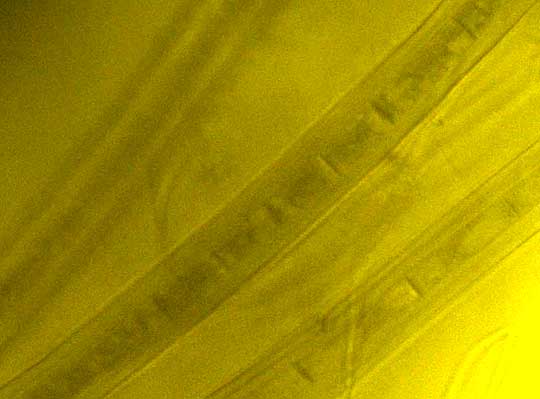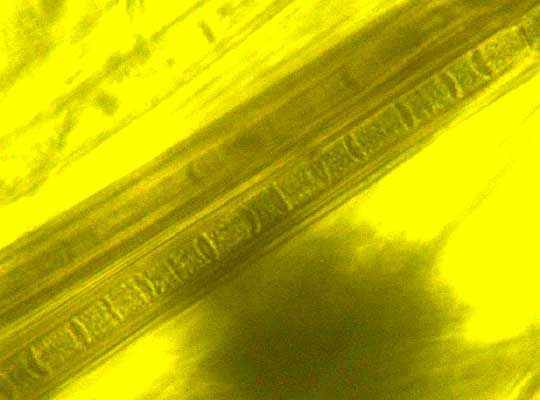Excerpts from Jim Conrad's
Naturalist Newsletter

from the January 5, 2014 Newsletter issued from the Frio Canyon Nature Education Center in the valley of the Dry Frio River in northern Uvalde County, southwestern Texas, on the southern border of the Edwards Plateau; elevation ~1750m (~5750 ft); N29.62°, W99.86°; USA
CYANOBACTERIA
Continuing the project of learning to associate the appearance of algae in the Dry Frio River with how they look under the microscope, I chose a dead, decaying, submerged stem of a Water Willow extending a few inches up from the river's floor and covered with a yellowish-green fuzz, which I assumed to be algae. Above, yYou can see the submerged stem with its covering of hairlike, 1cm long (3/8ths inch) filaments.
As soon as some filaments were seen under the microscope it was clear that we didn't have an alga at all. No cell wells were to be seen, as well as no photosynthesizing chloroplasts or any of the smaller organelles to be expected in an alga cell. Below, you can see what appeared:

The regularly spaced partition-like features within the filaments don't extend all the way to the filaments' sides the way they would if they were cell walls. Also, note the pale glow along the filaments' sides. That's light refracting through a thin, gelatinous covering of the filaments. Other filaments in the sample were at different stages of development, as seen below:

At the picture's top, left, there appears to be a kind of casing composed of the gelatinous covering from which the contents have escaped. Scanning more filaments, more states of development turned up, including the one filled with tiny, granular items shown below:

In November of 2012 while looking at patches of scum forming atop the Dry Frio we identified the scum-forming organism as a cyanobacterium, probably the genus Oscillatoria. That page is at https://www.backyardnature.net/n/x/scum.htm.
From what we learned then, we can suppose that once again we have a cyanobacterium, not an alga, but maybe this is a different one. One reason it might be different is that the gelatinous covering -- or "sheath," when speaking of cyanobacteria -- appears to be very thin or missing in Oscillatoria. Cyanobacteria are turning out to be much more interesting and commonly occurring than I'd thought. You might like to check out their Wikipedia page at https://en.wikipedia.org/wiki/Cyanobacteria.
One of the most mind-boggling facts about cyanobacteria is that early in the history of Life on Earth they consumed so much of the carbon dioxide in the atmosphere, through photosynthesis, and produced so much oxygen that they made life possible for us animals. A graph showing the change in the atmosphere's gas composition is at http://ircamera.as.arizona.edu/NatSci102/NatSci/text/atmosgases.jpg.
Cyanobacteria used to be called blue-green algae. Now most experts regard them as bacteria, but in truth they don't fit either category. Cyanobacteria don't have cell nuclei containing genetic material as do the algae, yet they photosynthesize, which bacteria in general don't do.
I'm not sure which cyanobacteria species this is. Browsing the Internet I get the impression that three important freshwater, filamentous genera to look for are Oscillatoria, Phormidium and Lyngbya. At one site I read that "Lyngbya is very similar to Phormidium, which has a looser sheath, and to Oscillatoria, which normally lacks a sheath." Some of our filaments seem to have pretty loose sheaths so that's a vote for Lyngbya, but some pictures of Phormidium on the Internet are somewhat similar to ours. That's as far as I can get with it.
Whatever the name of our twig's cyanobacterium, I'm eternally grateful for the enormous quantities of oxygen cyanobacteria have produced throughout the eons.